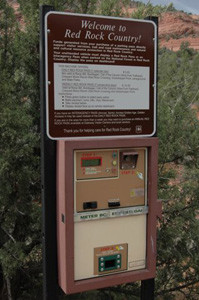 Fees are not “free money.” There are costs associated with collecting them, often very high costs. The Forest Service and BLM increasingly use third-parties to do their fee collection, and those private collection services don’t come cheap.
Fees are not “free money.” There are costs associated with collecting them, often very high costs. The Forest Service and BLM increasingly use third-parties to do their fee collection, and those private collection services don’t come cheap.
FLREA specifies that “The Secretary may use not more than an average of 15 percent of total revenues collected under this chapter for administration, overhead, and indirect costs related to the recreation fee program by that
Secretary.”
None of the agencies are staying within that 15% limit. Some even admit it, such as the National Park Service, which stated in the 2012 report to Congress that
“NPS policy is to keep cost of collection below 20%.” FLREA_FY2012_Triennial_Report
Other agencies are not so forthright about exceeding FLREA’s legal limitation, they just shift the costs into categories that they claim are neither administrative, overhead, nor indirect. For example, when the Forest Service uses a third-party to sell passes, there is a sales commission or “discount” paid, typically around 10%. So the agency does not get all the revenue the public pays, they only get 90% of it. But they don’t report that sales commission as a cost subject to the 15% limit.
For example, in Sedona, Arizona, where a Red Rocks Pass is required for a large number of sites, you can’t buy one from the Forest Service, you can only buy one from a third party. The sales commissions paid to pass sellers take an average of 22% of what you pay, including 48% when you buy a pass through one of the automated machines provided by a private vendor. But the Coconino National Forest says these commissions are a “direct” cost, not an “indirect” one, and thus not subject to the 15% limit in FLREA. Real_Rev-Expense_Chart
This practice of hiding vendor commissions, or “discounts,” dates back to the earliest days of Fee Demo and continues to the present, despite clear guidance from the Government Accountability Office that it violates federal accounting standards.
“The Forest Service practice of allowing vendor discounts results in
inaccurate fee revenue and expenditure reporting. Because the vendor
retains the discount rather than the Forest Service first collecting all fee
revenues and then paying the vendor out of these revenues, the amount of
fee revenues that the forest receives is reduced. In addition, the vendor
discounts are not included as part of fee collection costs. Thus, both fee
revenues and fee collection costs are underreported. Because of
inaccurate reporting of fee revenues and collection costs, the Forest
Service has no assurance that it is in compliance with the recreational fee
demonstration legislation requirement only allowing 15 percent of fee
revenues to be used for fee collection costs.”GAO-03-470 Fee Demo Audit
